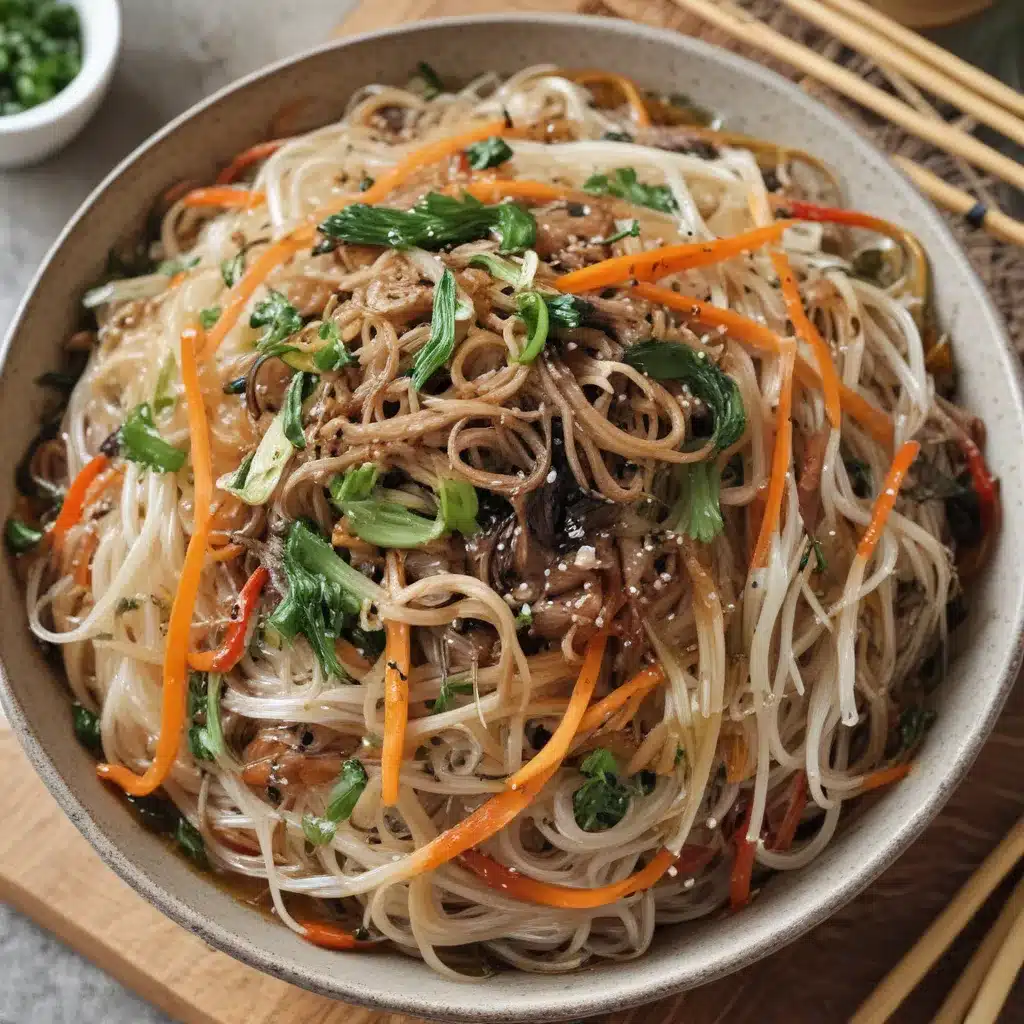
The Soulful Journey of Japchae
As I step into the bustling kitchen of Korean Garden, the scent of sizzling garlic and caramelized onions instantly transports me to the vibrant streets of Seoul. This humble dish, Japchae, is more than just a plate of stir-fried glass noodles – it’s a culinary adventure that captivates the senses and ignites the palate.
I’ve always been fascinated by the rich tapestry of Korean cuisine, and Japchae holds a special place in my heart. It’s a dish that seamlessly blends tradition with innovation, reflecting the dynamic essence of the Korean culinary landscape. From the delicate, translucent noodles to the perfectly balanced flavors, every bite tells a story of the nation’s heritage and the passion of its cooks.
The Art of Japchae
As I watch the skilled chefs at work, I’m mesmerized by the intricate dance of their movements. The wok sizzles with the rhythm of their stirring, as they expertly toss the noodles, vegetables, and protein together in a harmonious symphony. It’s a mesmerizing display of culinary artistry, where precision and instinct converge to create a dish that is nothing short of extraordinary.
One of the key elements that makes Japchae so captivating is the versatility of its ingredients. Sweet potato noodles, or “dangmyeon,” form the backbone of the dish, providing a delicate and chewy texture that serves as a canvas for the array of flavors. The chefs carefully select a medley of vegetables, each one contributing a unique texture and hue to the final creation. From the vibrant green of spinach to the earthy tones of shiitake mushrooms, the visual appeal of Japchae is as enthralling as its taste.
But it’s the intricate balance of sweet, savory, and umami notes that truly sets Japchae apart. The noodles are infused with a rich soy sauce and brown sugar marinade, creating a delightful interplay of sweetness and depth. The addition of sesame oil, garlic, and scallions lend a fragrant and savory touch, while the tender beef or juicy shrimp provide a satisfying protein element.
The Cultural Significance of Japchae
As I delve deeper into the history of this captivating dish, I’m struck by the cultural significance it holds in Korean society. Japchae has long been considered a celebratory food, traditionally served during special occasions such as weddings, Lunar New Year, and Chuseok (the Korean Thanksgiving).
The origins of Japchae can be traced back to the 17th century, when it was first introduced to the royal court of the Joseon dynasty. At the time, it was a luxurious dish, featuring rare and expensive ingredients like beef and pine mushrooms. Over the years, Japchae has evolved, becoming more accessible to the masses while still retaining its status as a beloved and iconic part of Korean culinary heritage.
One of the fascinating aspects of Japchae is its ability to adapt and reflect the changing times. As Korean cuisine has gained global recognition, Japchae has also found its way onto the menus of trendy fusion restaurants, where chefs experiment with new interpretations and flavor combinations. From adding a touch of spice to incorporating local seasonal produce, the versatility of Japchae allows it to seamlessly integrate into diverse culinary landscapes.
The Joys of Homemade Japchae
As much as I enjoy the expertly crafted Japchae at Korean Garden, there’s something deeply satisfying about creating this dish in the comfort of my own kitchen. The process of preparing Japchae is a meditative one, requiring a delicate touch and a keen understanding of the ingredients.
I start by carefully soaking the dangmyeon noodles, allowing them to transform from rigid strands into silky, translucent ribbons. As I chop the vegetables, I’m mindful of the textures and flavors, ensuring that each element complements the others. The sizzle of the wok, the aroma of toasted sesame seeds, and the gentle tossing of the noodles – these sensory experiences become a form of culinary meditation, a means of connecting with the rich traditions of Korean cuisine.
The true magic of homemade Japchae, however, lies in the ability to personalize the dish to suit your own preferences. Want a little more heat? A sprinkle of gochugaru (Korean chili flakes) can do the trick. Craving a touch of crunch? Toasted pine nuts or roasted cashews can add a delightful textural contrast. It’s in these small, customized touches that Japchae becomes a uniquely personal expression of your culinary journey.
Japchae: A Tapestry of Flavors and Memories
As I savor the final bites of my Japchae, I can’t help but reflect on the deep-rooted connections this dish has to Korean culture and my own personal experiences. Each mouthful is a symphony of flavors, a harmony of textures that transport me to the bustling streets of Seoul, the warmth of a family gathering, and the comforting embrace of home.
Japchae is more than just a meal – it’s a testament to the richness and diversity of Korean cuisine, a culinary ambassador that shares the story of a nation’s heritage and the passion of its people. Whether enjoyed in a restaurant or savored in the comfort of your own kitchen, Japchae has a way of evoking a sense of joy, nostalgia, and a deep appreciation for the art of cooking.
So, the next time you have the opportunity to indulge in this glass noodle delight, I encourage you to embrace the experience fully. Let the flavors dance on your palate, and allow the cultural significance of Japchae to resonate within you. Who knows, it just might become a new favorite, a dish that you’ll come to cherish as a gateway to the enchanting world of Korean cuisine.
